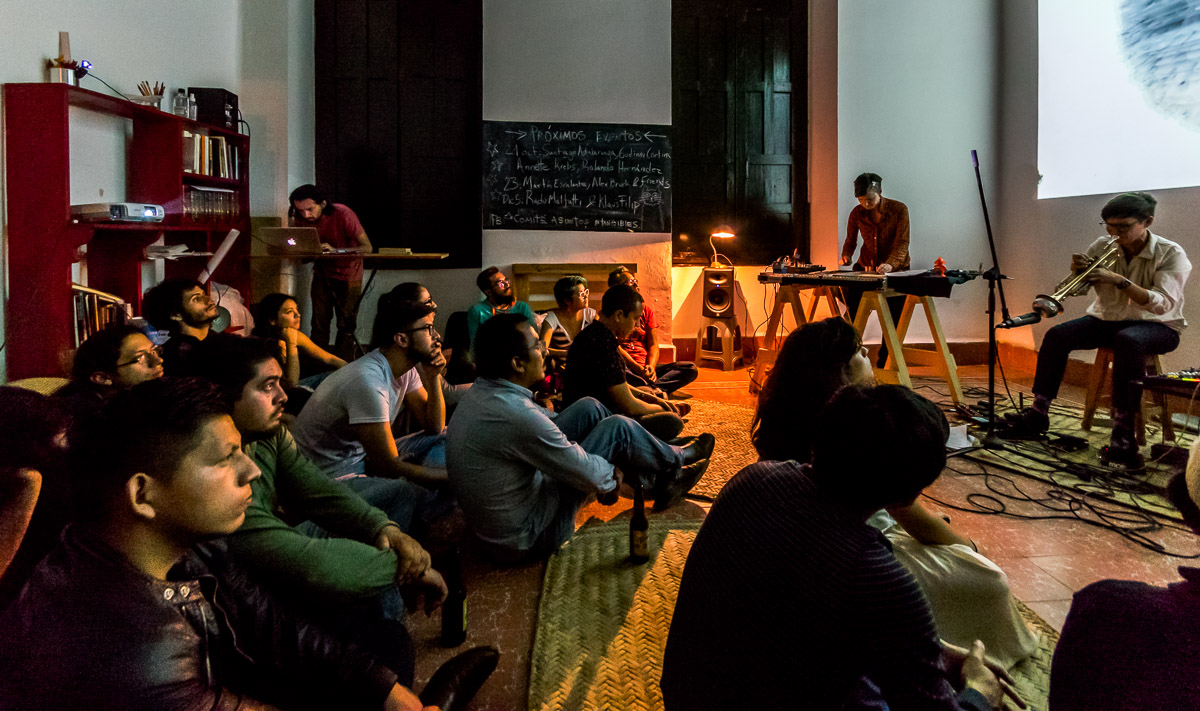One A Day – 889 – On Printing
Experiments in Sound & Music
- Comité de Asuntos Intangibles
- Música experimental desde Berlín: Ute Wasserman, Andrea Neumann y Sabine Ercklenz. Invitado especial Chris Cogburn y visuales de Paco Zúñiga
- Centro, Morelia, Michoacán, México
- October 11, 2016
- Copyright, all rights reserved
On the way back from another (less photogenic) event – a friend and I passed by this event and stayed. Small group and venue, attentive audience and lots of experimental work. Good to know we have people willing to be out there on the edge – it is the only way things progress.
On Printing
I’ve been pursuing getting printed versions of my work for quite sometime. I tried using local photo shops and other photographers with studios but ultimately nothing really fit what I wanted or gave me the control I felt I needed. In talking to one of the leading photoshops – the reason became obvious: They need to be set up for inexpensive, volume printing. For the most part they use large dye-sublimation machines that can spit out 100’s of photos at a time. These machines have little in the way of control or adjustments because in volume work, you don’t want to be fussing with a single order of a few prints. You are holding up production on many, many other jobs. And honestly, most people today have never seen real quality prints outside of a gallery (perhaps).
I finally decided to take the plunge and go for the best quality I could manage under my control and get a printer that can handle art papers and use archival inks. I’ve been using it now for a little more than a month and the results have been very good. I have an Epson SureColor P600 and I am using Finestura Art papers.
This combination allows me to print archival prints up to 13 inches wide by nearly unlimited length (it will take roll paper). And it allows front loading of art papers to avoid the kinks and skewing I’ve seen with other printers.
Printing is the ultimate expression of a photographer’s work. You can have lots of digital versions running around online (and I do), but the fullest possible interpretation is in versions printed on paper. I had lots of experience with printing in my days of film and “conventional” prints but the results of digital printing were never very good except with the highest end printers and labs for professionals that could charge high end prices. It can be frustrating to chase the “perfect” print – especially if someone else is controlling the printing. Getting a chance now to use an exhibition level printer and paper that I can control is very fulfilling thing.
Printing on this level requires some patience. Prints in reflected light have a completely different character than photos on the screens of digital devices. On LCDs, the whites are often too bright and the shadows don’t balance properly. As someone who used Ansel Adam’s Zone System, this can be very frustrating. Ultimately, you can’t control how people will experience your work at all because you can’t know how their screens are set up. Are they balanced? Do they have a good range of gamut and tone? Don’t even think about it. Generally the answer is no.
On good paper with a good printer – you can control the results and what your audience experiences. The combination I am using can’t be judged as it comes out of the printer. It literally “blooms” as it finishes the process of absorption and drying. It takes from 30 to 45 minutes to finally see the fully realized print. Just like with traditional photo printing – details, colors, and tones all change from the moment they leave the printer until the end of the process and it varies a bit from paper to paper with different prints. I’m currently using a natural matte paper that I like very much. Blacks are rich and deep. Highlights don’t block up – there is lots of detail and the detail can be very small indeed. Color can range from vibrant to very subtle. I’m getting better prints than I got in similar situations before I went to digital. And, the ability to “go big” when I want to – printing the equivalent of a 16×20 in most of my horizontally proportioned images – is quite satisfying.
So now it begins. I’m picking up seven photos today, mounted and framed. To the walls!

